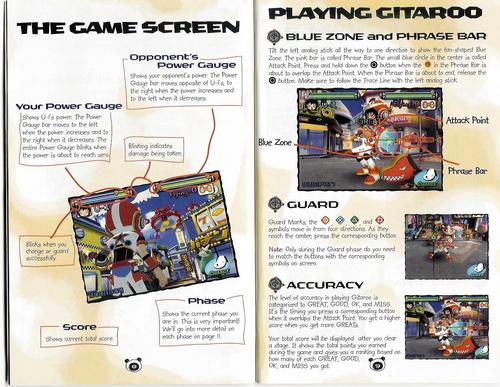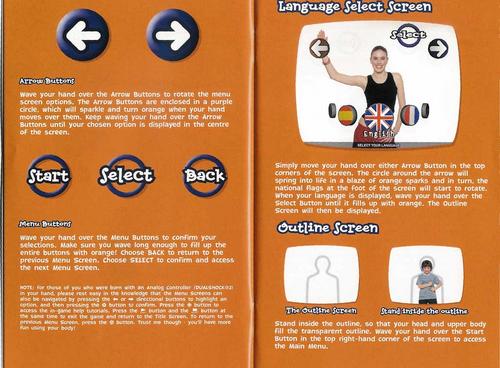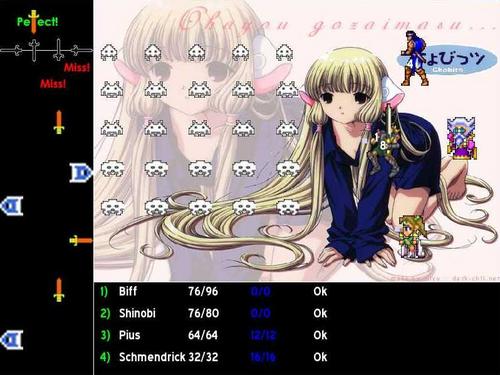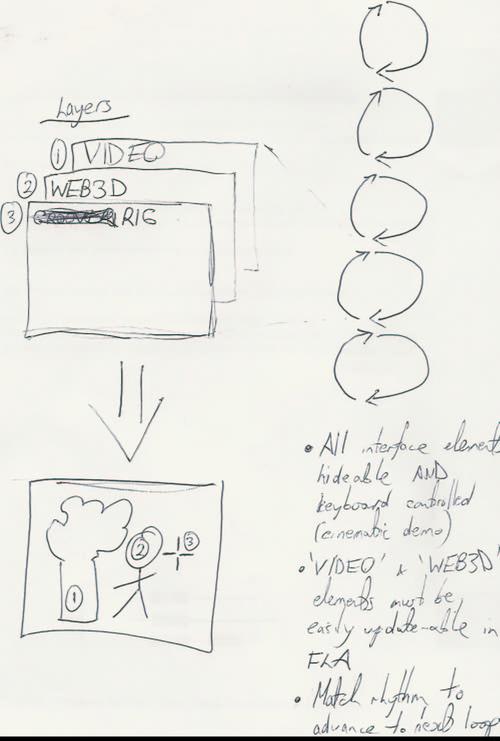July 07, 2004
Game control set samples
Here are the control instructions for the Playstation 2 titles, Eyetoy:Play and Gitaroo Man.
April 27, 2004
Tendrils - open rhythm game
Massive: Tendrils - rhythm combat
One to watch for Groover MOD and Community.
As a game it is fairly clunky as yet (and the 3D maze element is too retro confusing for me!) but it ticks several boxes as a useful case study. Tendrils relies on rhythm game mechanics, re-mixed game art, BitTorrent and Python.
March 23, 2004
Groove patterns ("Groover")
MIDI may end up being integral to authoring and prototyping groover (rhythm) patterns in the RIG. Using MIDI within Flash suggests one approach.
I.e. compose pattern in any MIDI package (e.g. Arkaos, Logic, Reason), clean via custom filter, load into Groover and
a) generate diagram from the pattern
b) monitor input and measure accuracy relative to the pattern
October 24, 2003
Groover experience map
EXPERIENCE OVERVIEW The prototype rhythm game (known as Groover) will demonstrate the potential of re-mixing and replacing film assets. Not all assets will be re-mixable but the idea is to embed as many re-mixable assets in the linear film as possible. There are four flavours of interactive elements considered re-mixable A) Audio-only D) 3D P) Panorama V) Video Groover functions as a walk-through the collection of assets. To "play" the film using Groover, the player needs to input the correct sequence of button presses in the right rhythm. Two rhythm pieces, level 1 and level 2, are presented to the player in "call and response" fashion. On the easiest settings, this means that CD (the character/GUI through which Groover is played) taps out the rhythm and then the player has to repeat it correctly. On harder settings, the rhythm the player has to do in response to CD will be much harder with more elaborate flourishes. For the purposes of prototyping, each level of the Groover is broken down into the GROOVE track (the rhythmic sequence of input events by player) the CONSEQUENCE track (events triggered by input if rhythm is correct) the PLAYBACK track (events which occur regardless of whether rhythm is correct or not)October 16, 2003
Flash groover concept map
Quick sketch of the behavior I'd like of the flash groover prototype. I want to be able to play through the storyboards and animatic content in development.
September 25, 2003
Groover
I think I can better describe Groover now. Been fiddling with assets for this gig. A lot of the files I've been given to mix with are rather low-res. It's made me dig up one of my old quicktime files, one of the first I consciously filed away. No watermark. Let's see who claims her. Let's use her as the example
Click and drag.
Chick pose
OK now obviously you can waggle her. But notice how the granularity of movement isn't good enough. Moving the mouse hand does change her but it's a bit blocky. Put on any music you like and you can make her groove to it with a bit of wiggling.
What I'd like for groover is a very low latency control interface so you can get more fluid movement. I'm starting to think that the actual movement of the image in response to your input can be extremely minimal. As long as its there and has a narrative context. The mental state of the film is very erratic so it doesn't have to be too obvious as long as its coloured a certain way.
e.g.
The default visual aesthetic can be quite low-res in places because either the State is having trouble getting a fix on Blake's mind or because Blake's systems themselves are humorously primitive. Bedroom computing kept simple.
I'm listening to Daft Punk (Rollin' and Scratchin') and giving myself heaps of mouse space to make patterns.
Taking the DVD multi-angle one step further. Would it be possible perhaps to seamlessly switch between 8 different video tracks all the way through the film? If so then the user could be given a very simple interface, a scrubber like, that let you fiddle. That alone with interactive audio might do the trick.
April 27, 2003
Director's platform
My revised brainstorm of what I'd like to see in a SANCTUARY prototype around Groover and Switch.
The aim of the platform is to demonstrate the fun and potential of the concept whilst building as little as possible.
Inspiration from Akio Morita, co-founder SONY
As a manager, marketer and brander, Morita brought Western ways to Japan and Japanese ways to the world. When the “pocket-sized” transistor radio Sony first developed turned out to be too large for a man’s shirt pocket, Morita sent salesmen out in shirts with specially-made deeper pockets.
The following uses terms explained in the Glossary.
PERFORMANCE FUNCTIONALITY
Certain functionality is desirable for performing the re-mixable film experience
- Flexible CONTROLLER LAYER mapping - groove tracks playable from multiple input devices
- Keyboard
- Mouse
- MIDI controller (e.g. Oxygen 8)
- Game input (e.g. joystick)
- Motion tracker (e.g. webcam)
- Pressure sensor (e.g. dance mat)
- Invisible interface - hide/reveal interface elements in the PRESENTATION LAYER, but not "fake" cinema elements.
- Dual monitor support - display interface elements on a separate monitor
- Adjustable Tempo - variable playback rate which can be set by typing in a value or tapping a key
- Groove autoplay - playback of the current groove with a single key
- Asset library - browse and load capability to select assets from disk or online (via a cache mechanism)
- Ability to edit/replace assets in off-the-shelf applications like Flash and Final Cut Pro.
- Client/server messaging. Facility for GROOVER to receive and send control events as XML via the network.
- Access to "easy" EFFECTS like Flash standard functionality
- Pan
- Zoom
- Rotate
- Skew
- Pan
- Ability to limit playback of any asset based on it being triggered at the appropriate time (the right Note). This is optional. A set of default events will be triggerable despite success/failure of rhythm game.
- Variable level of difficulty setting. Ability to fuzzy match controller events to Notes with a varying degree of accuracy to help rhythm-impaired users.
- Scoring capability based on success in matching the groove track with input.
- Each groove contains conditional logic to switch to a new groove based on success/failure to match the groove.
- Migration path to port (Flash) Groover prototype to a higher performance engine (e.g. Director, Virtools, Renderware).
- Asset compatibility with Arkaos (e.g. Flash text assets)



